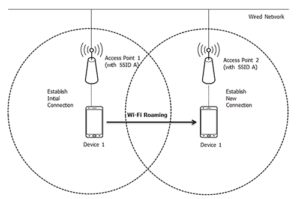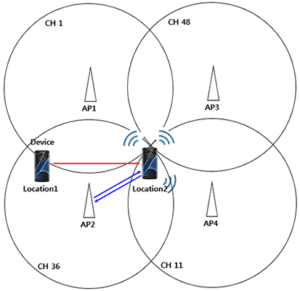 Wireless networks include the concept of roaming. This word refers to a station’s movement within a wireless network.
Wireless networks include the concept of roaming. This word refers to a station’s movement within a wireless network.
This is possible in Wi-Fi environments when multiple Access Points (APs) provide a wireless network service on the same Wi-Fi network. Mobile stations switch AP when they experience a weak signal. The decision to roam to another AP with better signal quality in the same network is made by the station with help from the AP it is currently connected to.

Figure 1: Station and connection moving to another access point with the same SSID
Roaming at base stations and access points
Roaming in Wi-Fi networks is done through two protocols. The 802.11k protocol is responsible for reporting link signal measurements between station and AP and helps the station in its objective to change AP within the Wi-Fi network while avoiding packet loss in the move. The 802.11v protocol forces the station to switch to another access point decided by the AP that is currently serving the station. There are various reasons why this occurs:
- The access point is going to reboot: When an AP is going to execute a management task, and this could lead to stations being disconnected.
- Channel utilization (CU): There are too many stations or the AP’s channel monitoring detects poor performance in the network.
- Weak signal level: Based on information about neighboring APs in the same network that have better received signal strength (RSSI), a decision can be made to change the station to another AP.
When the station decides to change to a new AP, it is usually due to three reasons:
- A weak signal quality: The AP’s current RSSI value is weak (below -75 dBm) so the device scans the band looking for an AP with a stronger signal.
- Loss of beacons: When beacons from a connected AP are not received after 2 seconds with an active station, the mobile device starts scanning for other APs within range.
- Channel utilization (CU): Multiple clients are connected to the same AP. Despite having a strong radio signal, connectivity may be disrupted due to network overload. When this is the case, the AP will notify clients of its current traffic using the CU factor in the beacons. The mobile device will start scanning if the received CU value is greater than 70% and the current RSSI value is between -65 and -75 dBm.
In order to avoiding scanning, and thus prevent packet loss in the traffic flow, a station can use the 802.11k protocol to help it switch to a new AP.
802.11k neighbor reports
The station makes the roaming decision and sends a Neighbor request packet to the AP to request information on neighbors with the same SSID as the AP that it is connected to.
The AP sends a Neighbor report to the station with a list of the APs in its scan table and information about the channels on which they are operating, thus saving the station from having to perform a full scan.
For this protocol to be effective, the access point must have performed a previous scan and received updated information on neighbors. Using CBS (Continuous background scanning), the AP contains an updated neighbor table in a short space of time.
802.11k beacon reports
The access point takes the initiative in roaming and asks the station for its perspective of the network. The station will inform the access point of the neighbors listed in its scan table, sending the RCPI value or signal strength and channel of the access points it has within range.
Using the 802.11v protocol, the AP currently connected to the station can use this information to help the station make roaming decisions.
802.11v BSS Transition Management
BSS Transition Management allows an AP to request a station to transition to a specific AP, or suggest a set of preferred APs, due to network load balancing or termination of the connection with the current AP. This helps the station identify the best AP from the list of candidates sent. In a network where APs are able to communicate with each other, this can lead to a very reliable set of APs. APs can constantly monitor using the Probe requests that the station sends containing its current signal value (RSSI).
Network scenario with a mobile station
Finally, we will look at a case where the 802.11k/v/r protocol is used to roam a station that changes location and loses the signal with the AP it is connected to.

Figure 2: Network scenario in which there are multiple access points and the roaming decision is assisted by the connected access point using 802.11k/v
In figure 2, the station changes location and once it decides to roam it requests information on neighbors through the 802.11k Neighbor report.
This provides it with information about nearby APs and the channels where they are operating. The client can request a list of candidates through the 802.11v BTM protocol.
If the roaming decision is made by the AP, a Beacon request will be sent through the 802.11k protocol to ask the station which access points are viable for the move. Based on the response, the AP will decide roaming guidance with a list of candidates. Once the candidates are sent, the station will re-associate with one of the access points on the list.
If the 802.11r protocol is enabled in this re-association process, the connection with the next access point will be even faster as it saves having to renegotiate security with the AP, reducing reconnection time from 200ms to less than 50ms and avoiding latency or packet loss during roaming.
In Teldat, these technologies and algorithms are used in W2022ac products configurable through the graphical user interface or managed by a controller, where the network environment consists of a Wi-Fi service with multiple access points providing network coverage.


























